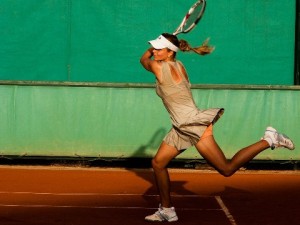

The shoulder sacrifices stability to be the most mobile joint in the body. The stability of the shoulder joint is provided by the anatomical design allowing the wide range of motion available at the joint. This becomes a fragile balance between stability and mobility especially with tennis players who are trying to generate the highest possible power when serving. The repeated serving mechanism of the abduction and external rotation movement carries an increased risk of overloading various structures around the shoulder.
To complete the tennis serve, the whole body must work together and there are five phases:
- Wind up – using the knees and trunk
- Early cocking
- Late cocking – maximum abduction and external rotation
- Acceleration
- Follow through
The perfect serve
To create the perfect serve, all the above phases must be working together. This means all aspects of the kinetic chain need to be in perfect shape to allow a sufficient energy level to produce the serve. The kinetic chain allows the transfer of forces through the legs to the hands. The majority of force is created in the legs, trunk and hips and delivered through the hands with the shoulders acting as the funnel of the forces. Any break or weakness in this chain will lead to an increase in demand on the distal components. Enhancing the functional ability of these segments results in the same energy level being created meaning they must work harder to perform to the same level. Due to this, the distal components of the kinetic chain are more susceptible to overuse injuries than the proximal parts.
The scapula acts as a stable base for the humeral head during the overhead motion during the tennis serve. It also moves around the thoracic wall while the arm moves through the early cocking phase to late cocking phase. The scapula also must move upwards to clear the acromion from the humeral head. The scapula forms a stable base for the muscles to control the arm motion and the position of the scapula against the thorax. The serratus anterior and trapezius act to stabilise the scapula against the thoracic wall. Elevating the scapula is from the upper and lower trapezius muscles. Dysfunction of these muscles can lead to scapula dyskinesis. This can be through direct injury or because of pain causing muscle inhibition.
There are three types of scapula dyskinesis and with each type different shoulder injuries are more likely. For example, type 3 where the superior medial border of the scapula is prominent is often associated with sub-acromial impingement and rotator cuff injury. The term SICK scapula is often used to highlight how the scapula is presenting i.e. position, medial border prominence and movement. It is often characterised by drooping shoulders which is thought to lead to shoulder injuries. The anterior coracoid pain can often be mistakenly attributed to anterior shoulder pain, instability or labral tears when it is actually the anterior tilted scapula. The posterior shoulder pain is from the chronic tightness of the levator scapula by the abducted and protracted scapula.
Set point
Shoulder injuries can be caused by issues within the kinetic chain causing the more distal components to become overused. Secondly, the scapula has significant importance in the role of serving and issues with the scapula can lead to rotator cuff and overuse injuries. It is important to seek medical advice if you begin to notice shoulder symptoms. Do not ignore them as treating them early can help keep you on the court.